ARTS / CULTURE & LEISURE
Documentary ‘Underwater China’ reveals hidden side of ancient country
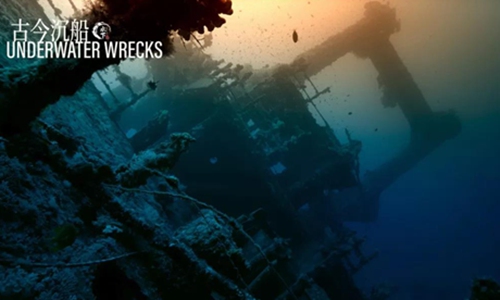
A sunken ship. Photo: Courtesy of Dive the World
Can you imagine that an ancient town and a 50-kilometer-long section of the Great Wall of China have silently stood underwater for dozens of years? Have you ever seen coral giving birth underwater?A new documentary, Underwater China, reveals submerged caves, secret gardens and broken shipwrecks from several thousand years ago. Although this is a tranquil silent world, its wonders easily rival those of the world above water.
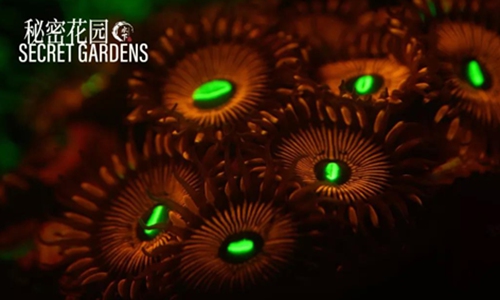
A scecret garden underwater. Photo: Courtesy of Dive the World
Some viewers have compared Underwater China, the world's first documentary revealing the underwater world of the ancient nation, with the Blue Planet series produced by BBC.Zhou Fang, chief director of Underwater China, said that the show is rather different from BBC's work.
"We shot China's own underwater world to help viewers better understand people and the country through these underwater locations, rather than just passively look at them," Zhou said.
Underwater town, Great Wall and shipwrecks
From February 2017 to August 2019, six cameramen, including Zhou, visited 24 cities around China, reaching as far north as Long Island, where the Yellow Sea meets the Bohai Sea, as far south as the South China Sea and as far east as Lanyu Island off the coast of the island of Taiwan.
The crew recorded an underwater town that has sat beneath the surface of Thousand Island Lake in Hangzhou, East China's Zhejiang Province, since 1959.
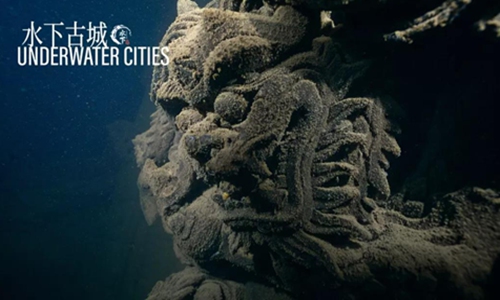
The ancient town under the Qiandao Lake. Photo: Coutersy of Dive the World
To help better understand the underwater town, the production team interviewed the original residents of the town.
One of residents surnamed Xu recalled his old house in the town, inspiring Zhou to choose Xu's house as the lynchpin of one episode. "These old private houses can tell many moving stories," Zhou said.
Xu told the production team that his house was called Qing Yu Tang, and a stone tablet was hung on the door. He remembered there was a fallen tree in the yard and a staircase in the backyard that led to the second floor.
Before photographers got ready for the water shoot, Xu asked Zhou if she could bring back one of the house tiles, which Zhou agreed to do.
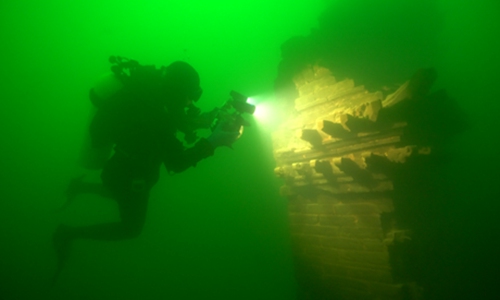
Zhou Fang is filming underwater. Photo: Courtesy of Dive the World
Zhou successfully found Xu's house underwater, perfectly preserved. The tiled roof looked exactly as it did when it sank beneath the rising waters more than 60 years ago.Although Zhou picked up a roof tile to bring back, she ended up putting it back where she found it. "I struggled for a long time, but still decided to let the tile stay. It should be left at a memory of 60 years ago."
Zhou told the Global Times that there is a 300-year-old memorial archway in the underwater town, the only underwater archway in China that has not collapsed.
"I saw the stone head of a dragon on the archway. In a flash, it gave me the sense that I had a mission. I felt that I had to show this underwater world to the public," Zhou said.
The production team went to North China's Hebei Province to shoot another underwater wonder - a roughly 50-kilometer-long section of the Great Wall.
This section of the Great Wall was submerged in the waters of the Luanhe River due to the construction of the Panjiakou Reservoir.
"The water temperature is 6 C and visibility can be up to 10 meters. This is the most gorgeous Great Wall I have ever seen!" Zhou said.
The documentary also talks about the evolution of sunken ships, from a merchant ship of the Song Dynasty (960-1279) that sunk in the South China Sea to a oceangoing freighter of South Korea that sunk near the island of Taiwan in 1983.
Filming experience
Zhou and her team risked their lives to shoot some underwater natural scenes in some dark caves in South China's Guangxi Zhuang Autonomous Region. One of the main attractions of these caves are blind shrimp, one of the rarest types of aquatic cave life.
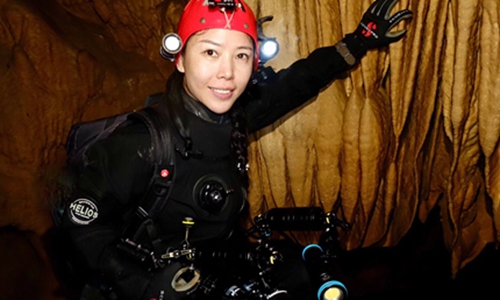
Zhou Fang. Photo: Courtesy of Dive the World
Zhou had quite a scare while shooting the blind shrimp. She and another crew member were so excited to them, that they forgot they had entered a deep cave without a guide rope."I almost suffocated in that cave," Zhou said, noting that even talking about the experience still scares her.
"Our biggest problem during filming was a lack of historical information and materials," she told the Global Times.
To collect the information they needed, the crew read lots of related books and visited many institutions and diving clubs.
"We had to explore this completely unknown world by ourselves," Zhou explained.
Underwater shooting is greatly dependant on weather and other conditions, so it is one of the more difficult documentaries to shoot.
Zhou said she wants to record more underwater stories from China, such as the stories of the Three Gorges and other rivers and lakes.
"The documentary is a starting point to explore the unknown world of our country instead of a finishing line. I hope more people can come to better understand and respect nature through this work," Zhou said.

